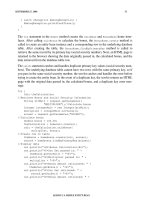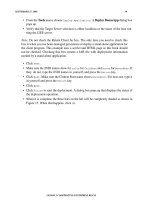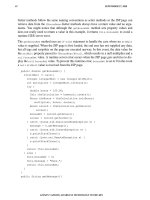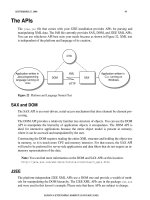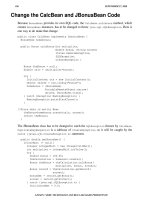Ivor Horton’s Beginning Java 2, JDK 5 Edition phần 1 pdf
Bạn đang xem bản rút gọn của tài liệu. Xem và tải ngay bản đầy đủ của tài liệu tại đây (2.47 MB, 151 trang )
Ivor Horton’s Beginning Java
™
2,
JDK
™
5 Edition
01_568744 ffirs.qxd 11/23/04 9:27 PM Page i
01_568744 ffirs.qxd 11/23/04 9:27 PM Page ii
Ivor Horton’s Beginning Java
™
2,
JDK
™
5 Edition
Ivor Horton
01_568744 ffirs.qxd 11/23/04 9:27 PM Page iii
Ivor Horton’s Beginning Java
™
2, JDK
™
5 Edition
Published by
Wiley Publishing, Inc.
10475 Crosspoint Boulevard
Indianapolis, IN 46256
www.wiley.com
Copyright © 2005 by Ivor Horton
Published by Wiley Publishing, Inc., Indianapolis, Indiana
Published simultaneously in Canada
ISBN: 0-7645-6874-4
Manufactured in the United States of America
10 9 8 7 6 5 4 3 2 1
5B/RU/RS/QU/IN
No part of this publication may be reproduced, stored in a retrieval system or transmitted in any form or by any
means, electronic, mechanical, photocopying, recording, scanning or otherwise, except as permitted under Sections
107 or 108 of the 1976 United States Copyright Act, without either the prior written permission of the Publisher, or
authorization through payment of the appropriate per-copy fee to the Copyright Clearance Center, 222 Rosewood
Drive, Danvers, MA 01923, (978) 750-8400, fax (978) 646-8600. Requests to the Publisher for permission should be
addressed to the Legal Department, Wiley Publishing, Inc., 10475 Crosspoint Blvd., Indianapolis, IN 46256, (317)
572-3447, fax (317) 572-4355, e-mail:
LIMIT OF LIABILITY/DISCLAIMER OF WARRANTY: THE PUBLISHER AND THE AUTHOR MAKE NO REP-
RESENTATIONS OR WARRANTIES WITH RESPECT TO THE ACCURACY OR COMPLETENESS OF THE CON-
TENTS OF THIS WORK AND SPECIFICALLY DISCLAIM ALL WARRANTIES, INCLUDING WITHOUT
LIMITATION WARRANTIES OF FITNESS FOR A PARTICULAR PURPOSE. NO WARRANTY MAY BE CREATED
OR EXTENDED BY SALES OR PROMOTIONAL MATERIALS. THE ADVICE AND STRATEGIES CONTAINED
HEREIN MAY NOT BE SUITABLE FOR EVERY SITUATION. THIS WORK IS SOLD WITH THE UNDERSTAND-
ING THAT THE PUBLISHER IS NOT ENGAGED IN RENDERING LEGAL, ACCOUNTING, OR OTHER PRO-
FESSIONAL SERVICES. IF PROFESSIONAL ASSISTANCE IS REQUIRED, THE SERVICES OF A COMPETENT
PROFESSIONAL PERSON SHOULD BE SOUGHT. NEITHER THE PUBLISHER NOR THE AUTHOR SHALL BE
LIABLE FOR DAMAGES ARISING HEREFROM. THE FACT THAT AN ORGANIZATION OR WEBSITE IS
REFERRED TO IN THIS WORK AS A CITATION AND/OR A POTENTIAL SOURCE OF FURTHER INFORMA-
TION DOES NOT MEAN THAT THE AUTHOR OR THE PUBLISHER ENDORSES THE INFORMATION THE
ORGANIZATION OR WEBSITE MAY PROVIDE OR RECOMMENDATIONS IT MAY MAKE. FURTHER, READ-
ERS SHOULD BE AWARE THAT INTERNET WEBSITES LISTED IN THIS WORK MAY HAVE CHANGED OR
DISAPPEARED BETWEEN WHEN THIS WORK WAS WRITTEN AND WHEN IT IS READ.
For general information on our other products and services or to obtain technical support, please contact our Cus-
tomer Care Department within the U.S. at (800) 762-2974, outside the U.S. at (317) 572-3993 or fax (317) 572-4002.
For technical support, please visit
www.wiley.com/techsupport.
Wiley also publishes its books in a variety of electronic formats. Some content that appears in print may not be
available in electronic books.
Library of Congress Cataloging-in-Publication Data
Horton, Ivor.
Ivor Horton’s Beginning Java 2, JDK 5 Edition / Ivor Horton.
p. cm.
Includes index.
ISBN 0-7645-6874-4 (paper/website)
1. Java (Computer program language) I. Title: Ivor Horton’s Beginning Java 2, JDK 5 Edition. II. Title.
QA76.73.J38H6758 2004
005.13’3—dc22
2004017036
Trademarks: Wiley, the Wiley Publishing logo, Wrox, the Wrox logo, Programmer to Programmer, and related
trade dress are trademarks or registered trademarks of John Wiley & Sons, Inc. and/or its affiliates, in the United
States and other countries, and may not be used without written permission. Java and JDK are trademarks of Sun
Microsystems, Inc. All other trademarks are the property of their respective owners. Wiley Publishing, Inc., is not
associated with any product or vendor mentioned in this book.
01_568744 ffirs.qxd 11/23/04 9:27 PM Page iv
About the Author
Ivor Horton started out as a mathematician, but shortly after graduating, he was lured into messing
about with computers by a well-known manufacturer. He has spent many happy years programming
occasionally useful applications in a variety of languages as well as teaching mainly scientists and engi-
neers to do likewise. He has extensive experience in applying computers to problems in engineering
design and to manufacturing operations in a wide range of industries. He is the author of a number of
tutorial books on programming in C, C++, and Java. When not writing programming books or provid-
ing advice to others, he leads a life of leisure.
01_568744 ffirs.qxd 11/23/04 9:27 PM Page v
01_568744 ffirs.qxd 11/23/04 9:27 PM Page vi
01_568744 ffirs.qxd 11/23/04 9:27 PM Page viii
Credits
Executive Editor
Robert Elliott
Senior Development Editor
Kevin Kent
Technical Editors
Calvin Austin, J2SE 5.0 Specification Lead, Sun
Microsystems
Wiley-Dreamtech India Pvt Ltd
Production Editor
William A. Barton
Copy Editor
Luann Rouff
Editorial Manager
Mary Beth Wakefield
Vice President & Executive Group Publisher
Richard Swadley
Vice President and Publisher
Joseph B. Wikert
Project Coordinator
Erin Smith
Graphics and Production Specialists
Karl Brandt
Jonelle Burns
Kelly Emkow
Carrie Foster
Lauren Goddard
Denny Hager
Joyce Haughey
Jennifer Heleine
Ron Terry
Quality Control Technicians
Joe Niesen
Susan Moritz
Brian H. Walls
Media Development Specialist
Travis Silvers
Proofreading and Indexing
TECHBOOKS Production Services
Cover Photograph
© Ian Capener
01_568744 ffirs.qxd 11/23/04 9:27 PM Page vii
Foreword
You are probably reading this foreword with one of several things in mind. First, is this the right book
for me, is the material current, and does the text reflect the final API? Second, what should I expect to
learn and where should I start reading a book of this length?
Many of the forewords I have seen will lead you through an amusing anecdote or story and then men-
tion a little about the author, but then fail to leave you any wiser about the answer to those questions. So,
to get straight to the point and to answer the second question first, this is a book that you can start from
page one and read right through to the end. If you haven’t read any of Ivor Horton’s books before, you
are in for a pleasant surprise. Ivor’s style is very accessible, which makes the content easy to follow and
understand. I know, because I have read this book from cover to cover.
This edition of Ivor Horton’s Beginning Java 2, JDK 5 Edition is based on the J2SE 5.0 platform. The J2SE 5.0
release is one of the most significant updates to the Java platform in many years and has been three
years in the making. The release involved 160 experts worldwide, all working through the Java
Community Process and focused on making the platform better for all developers. I have been involved
with the project since day one as the Specification Lead for JSR 176, which defines the contents of J2SE
5.0. As such, I had a great interest in making sure that this book is accurate and matches the final API set.
I’ve even compiled and run every code example twice, and there are a lot of great examples, as you will
find out.
So what can you expect to learn from this new edition? First, Ivor covers the basic programming blocks
and gets you started with your first Java program. Ivor then introduces the Java language changes step
by step, including the new generic types, the enhanced
for loop, enumerated types, and many others.
You will also get to use the new language changes in later chapters and learn some of the other non-
language features, such as XML DOM3 updates. So whether you are a new developer or already have
some Java programming experience, you will gain the skills needed to work with the latest Java release.
In closing, I encourage you to read and enjoy what JDK 5.0 has to offer and find out how easy using J2SE
5.0 really is.
Calvin Austin
J2SE 5.0 Specification Lead
Sun Microsystems
01_568744 ffirs.qxd 11/23/04 9:27 PM Page ix
01_568744 ffirs.qxd 11/23/04 9:27 PM Page x
01_568744 ffirs.qxd 11/23/04 9:27 PM Page xii
Acknowledgments
While a book is usually attributed to the author, a book—particularly a large book such as this —is
always the result of the efforts of a sizeable team of people. I’d therefore like to thank all the editorial
and production staff at Wiley who worked so hard to produce this fifth edition of my Java tutorial from
my initial draft.
I’d especially like to thank Calvin Austin of Sun Microsystems for his extensive technical input. He
somehow found the time to go through the complete text and try out all the examples—twice — in spite
of the considerable demands of his day job. Calvin’s suggestions for improvements were invaluable, as
was his ability to spot my mistakes, and I’m particularly grateful for his indications of where I’d missed
some of the inevitable changes arising from the evolution of the J2SE 5.0 API during the beta phases.
Any errors that remain are, of course, my own, but there are surely fewer of them as a consequence of
Calvin’s efforts.
I’d also like to thank readers of past editions of Ivor Horton’s Beginning Java for their numerous sugges-
tions for corrections and improvements. In addition to the many changes that I made in response to
these, I also updated and reintroduced the chapters on using JDBC that were omitted from the previous
edition, in response to requests from a number of readers. The greatly increased page count of this edi-
tion over the previous edition is only in part a consequence of restoring the JDBC tutorial. The bulk of
the additional page count is attributable to new material relating to the features introduced by J2SE 5.0
that deliver exciting new capabilities for every Java programmer. The J2SE 5.0 release is truly a major
step forward that encompasses important extensions to the Java language as well as major additions to
the class libraries.
Finally I’d like to thank my wife, Eve, who provides unstinting support for whatever I happen to be
doing and cheerfully accepts my complaints about the workload that I freely elected to undertake. She
always manages to be on hand whenever I need sustenance or sympathy, or both, and undoubtedly I
would never have finished this book without her.
Ivor Horton
01_568744 ffirs.qxd 11/23/04 9:27 PM Page xi
Contents
About the Author v
Foreword ix
Acknowledgments xi
Introduction xxxvii
Chapter 1: Introducing Java 1
What Is Java All About? 1
Features of the Java Language 2
Learning Java 3
Java Programs 3
Learning Java — The Road Ahead 3
The Java Environment 4
Java Program Development 5
Installing the JDK 6
Compiling a Java Program 8
Executing a Java Application 9
Executing an Applet 10
Object-Oriented Programming in Java 12
So What Are Objects? 13
What Defines a Class of Objects? 14
Operating on Objects 17
Java Program Statements 19
Encapsulation 20
Classes and Data Types 20
Classes and Subclasses 21
Advantages of Using Objects 21
Java Program Structure 21
Java’s Class Library 22
Java Applications 24
Java and Unicode 27
Summary 27
Resources 28
02_568744 ftoc.qxd 11/23/04 9:25 PM Page xiii
xiv
Contents
Chapter 2: Programs, Data, Variables, and Calculation 29
Data and Variables 29
Naming Your Variables 30
Variable Names and Unicode 31
Variables and Types 31
Integer Data Types 31
Integer Literals 33
Declaring Integer Variables 34
Floating-Point Data Types 36
Floating-Point Literals 36
Declaring Floating-Point Variables 37
Fixing the Value of a Variable 37
Arithmetic Calculations 38
Integer Calculations 39
Producing Output 44
Integer Division and Remainders 45
The Increment and Decrement Operators 46
Computation with Shorter Integer Types 48
Errors in Integer Arithmetic 49
Floating-Point Calculations 49
Other Floating-Point Arithmetic Operators 50
Error Conditions in Floating-Point Arithmetic 51
Mixed Arithmetic Expressions 51
Explicit Casting 52
Automatic Type Conversions in Assignments 52
The op= Operators 53
Mathematical Functions and Constants 54
Importing the Math Class Methods 59
Storing Characters 60
Character Escape Sequences 60
Character Arithmetic 61
Bitwise Operations 63
Using the AND and OR Operators 65
Using the Exclusive OR Operator 68
Shift Operations 70
Methods for Bitwise Operations 74
Variables with a Fixed Set of Integer Values 77
Boolean Variables 79
Operator Precedence 80
Program Comments 81
Documentation Comments 82
02_568744 ftoc.qxd 11/23/04 9:25 PM Page xiv
xvi
Contents
Accessing Array Elements 138
Reusing Array Variables 138
Initializing Arrays 139
Using a Utility Method to Initialize an Array 140
Initializing an Array Variable 141
Using Arrays 142
Using the Collection-Based for Loop with an Array 143
Arrays of Arrays 145
Arrays of Arrays of Varying Length 149
Multidimensional Arrays 151
Arrays of Characters 152
Strings 152
String Literals 153
Creating String Objects 153
Arrays of Strings 155
Operations on Strings 157
Joining Strings 157
Comparing Strings 161
Comparing Strings for Equality 163
String Interning 166
Checking the Start and End of a String 167
Sequencing Strings 167
Accessing String Characters 169
Extracting String Characters 170
Searching Strings for Characters 172
Searching for Substrings 173
Extracting Substrings 177
Tokenizing a String 179
Modified Versions of String Objects 182
Creating Character Arrays from String Objects 182
Using the Collection-Based for Loop with a String 183
Obtaining the Characters in a String as an Array of Bytes 183
Creating String Objects from Character Arrays 184
Mutable Strings 184
Creating StringBuffer Objects 185
The Capacity of a StringBuffer Object 186
Changing the String Length for a StringBuffer Object 188
Adding to a StringBuffer Object 189
Appending a Substring 189
Appending Basic Types 190
Finding the Position of a Substring 191
Replacing a Substring in the Buffer 192
Inserting Strings 192
02_568744 ftoc.qxd 11/23/04 9:25 PM Page xvi
xv
Contents
Summary 83
Exercises 84
Chapter 3: Loops and Logic 85
Making Decisions 85
Making Comparisons 86
The if Statement 87
Statement Blocks 88
The else Clause 90
Nested if Statements 91
Comparing Enumeration Values 94
Logical Operators 95
Logical AND Operations 95
&& versus & 97
Logical OR Operations 98
Boolean NOT Operations 98
Character Testing Using Standard Library Methods 99
The Conditional Operator 100
The switch Statement 102
The General Case of the switch Statement 104
Variable Scope 108
Loops 111
Varieties of Loop 112
Counting Using Floating-Point Values 117
Nested Loops 121
The continue Statement 123
The Labeled continue Statement 123
Using the break Statement in a Loop 124
Breaking Indefinite Loops 127
The Labeled break Statement 128
Assertions 130
More Complex Assertions 132
Summary 133
Exercises 134
Chapter 4: Arrays and Strings 135
Arrays 135
Array Variables 136
Defining an Array 136
The Length of an Array 137
02_568744 ftoc.qxd 11/23/04 9:25 PM Page xv
xvii
Contents
Extracting Characters from a Mutable String 193
Other Mutable String Operations 193
Creating a String Object from a StringBuffer Object 194
Summary 196
Exercises 197
Chapter 5: Defining Classes 199
What Is a Class? 200
Fields in a Class Definition 200
Methods in a Class Definition 202
Accessing Variables and Methods 203
Defining Classes 204
Defining Methods 205
Returning from a Method 206
The Parameter List 206
How Argument Values Are Passed to a Method 208
Final Parameters 209
Defining Class Methods 209
Accessing Class Data Members in a Method 209
The Variable this 210
Initializing Data Members 211
Using Initialization Blocks 212
Constructors 215
The Default Constructor 216
Creating Objects of a Class 217
Passing Objects to a Method 218
The Lifetime of an Object 219
Defining and Using a Class 220
Method Overloading 222
Multiple Constructors 223
Calling a Constructor from a Constructor 225
Duplicating Objects Using a Constructor 226
Using Objects 227
Creating a Point from Two Lines 230
Recursion 233
Understanding Packages 236
Packaging Up Your Classes 237
Packages and the Directory Structure 237
Compiling a Package 238
Accessing a Package 239
Using Extensions 240
Adding Classes from a Package to Your Program 241
02_568744 ftoc.qxd 11/23/04 9:25 PM Page xvii
xviii
Contents
Packages and Names in Your Programs 241
Importing Static Class Members 242
Standard Packages 243
Standard Classes Encapsulating the Primitive Data Types 244
Controlling Access to Class Members 246
Using Access Attributes 246
Specifying Access Attributes 248
Choosing Access Attributes 250
Using Package and Access Attributes 251
Nested Classes 256
Static Nested Classes 257
Using a Non-Static Nested Class 262
Using a Nested Class Outside the Top-Level Class 263
Local Nested Classes 264
The finalize() Method 265
Native Methods 266
Summary 266
Exercises 267
Chapter 6: Extending Classes and Inheritance 269
Using Existing Classes 269
Class Inheritance 271
Inheriting Data Members 272
Hidden Data Members 273
Inherited Methods 273
Objects of a Derived Class 274
Deriving a Class 275
Derived Class Constructors 275
Calling the Base Class Constructor 276
Overriding a Base Class Method 277
Choosing Base Class Access Attributes 279
Polymorphism 279
Using Polymorphism 282
Multiple Levels of Inheritance 286
Abstract Classes 287
The Universal Superclass 288
The toString() Method 289
Determining the Type of an Object 289
Copying Objects 291
Methods Accepting a Variable Number of Arguments 295
Limiting the Types in a Variable Argument List 297
02_568744 ftoc.qxd 11/23/04 9:25 PM Page xviii
xix
Contents
Casting Objects 298
When to Cast Objects 300
Identifying Objects 301
More on Enumerations 302
Adding Members to an Enumeration Class 303
Designing Classes 307
A Classy Example 307
Designing the PolyLine Class 309
A General-Purpose Linked List 313
Using the final Modifier 317
Interfaces 318
Encapsulating Constants in a Program 319
Constants in an Interface 320
Constants Defined in a Class 321
Interfaces Declaring Methods 323
A Partial Interface Implementation 324
Extending Interfaces 325
Interfaces and Multiple Inheritance 326
Using Interfaces 326
Interfaces and Polymorphism 327
Using Multiple Interfaces 333
Method Parameters of Interface Types 333
Nesting Classes in an Interface Definition 334
Interfaces and the Real World 334
Anonymous Classes 335
Summary 335
Exercises 337
Chapter 7: Exceptions 339
The Idea Behind Exceptions 339
Types of Exceptions 340
Error Exceptions 341
RuntimeException Exceptions 342
Other Subclasses of Exception 343
Dealing with Exceptions 344
Specifying the Exceptions a Method Can Throw 344
Handling Exceptions 345
The try Block 345
The catch Block 345
try catch Bonding 347
Multiple catch Blocks 349
The finally Block 350
02_568744 ftoc.qxd 11/23/04 9:25 PM Page xix
xxi
Contents
Chapter 9: Accessing Files and Directories 401
Working with File Objects 401
Creating File Objects 402
Portable Path Considerations 404
Absolute and Relative Paths 404
Accessing System Properties 405
Setting System Properties 407
Testing and Checking File Objects 408
Querying Files and Directories 409
Filtering a File List 414
Creating and Modifying Files and Directories 417
Creating File Output Streams 419
Ensuring a File Exists 421
Avoiding Overwriting a File 423
FileDescriptor Objects 424
Summary 425
Exercises 425
Chapter 10: Writing Files 427
File I/O Basics 427
File Input and Output 429
Channels 430
Channel Operations 431
File Channels 433
Buffers 434
Buffer Capacity 434
Buffer Position and Limit 435
Setting the Position and Limit 437
Creating Buffers 438
View Buffers 439
Duplicating and Slicing Buffers 441
Creating Buffers by Wrapping Arrays 443
Wrapping Strings 445
Marking a Buffer 446
Buffer Data Transfers 446
Transferring Data into a Buffer 447
Using View Buffers 449
Preparing a Buffer for Output to a File 449
Writing to a File 451
File Position 453
Using a View Buffer to Load Data into a Byte Buffer 458
02_568744 ftoc.qxd 11/23/04 9:25 PM Page xxi
xx
Contents
Structuring a Method 351
Execution Sequence 352
Normal Execution of a Method 355
Execution When an Exception Is Thrown 356
Execution When an Exception Is Not Caught 357
Nested try Blocks 358
Rethrowing Exceptions 359
Exception Objects 359
The Throwable Class 359
Standard Exceptions 362
Defining Your Own Exceptions 362
Defining an Exception Class 363
Throwing Your Own Exception 363
An Exception Handling Strategy 364
An Example of an Exception Class 364
Summary 368
Exercises 368
Chapter 8: Understanding Streams 371
Streams and the New I/O Capability 371
Understanding Streams 372
Input and Output Streams 373
Binary and Character Streams 374
The Classes for Input and Output 375
Basic Input Stream Operations 375
Basic Output Stream Operations 379
Stream Readers and Writers 379
Using Readers 381
Using Writers 382
The Standard Streams 384
Getting Data from the Keyboard 384
Tokenizing a Stream 385
Customizing a Stream Tokenizer 387
Writing to the Command Line 392
The printf() Method 392
Formatting Numerical Data 394
Specifying the Width and Precision 395
Formatting Characters and Strings 396
The Locale Class 397
Formatting Data into a String 398
Summary 399
Exercises 399
02_568744 ftoc.qxd 11/23/04 9:25 PM Page xx
xxii
Contents
Writing Varying Length Strings to a File 460
Using a Formatter Object to Load a Buffer 462
Direct and Indirect Buffers 466
Writing Numerical Data to a File 467
Writing Mixed Data to a File 471
Gathering-Write Operations 477
Summary 481
Exercises 482
Chapter 11: Reading Files 483
File Read Operations 483
Creating File Input Streams 484
File Channel Read Operations 485
Reading a Text File 488
Getting Data from the Buffer 489
Reading Binary Data 491
Reading Mixed Data 496
Compacting a Buffer 499
Copying Files 502
Random Access to a File 507
Read/Write Operations with a Single File Channel 512
Memory-Mapped Files 513
Locking a File 517
Locking Part of a File 519
Practical File Locking Considerations 519
Summary 523
Exercises 524
Chapter 12: Serializing Objects 525
Storing Objects in a File 525
Writing an Object to a File 526
Writing Basic Data Types to an Object Stream 528
Implementing the Serializable Interface 529
Conditions for Serialization 532
Transient Data Members of a Class 533
Reading an Object from a File 533
Determining the Class of a Deserialized Object 537
Reading Basic Data from an Object Stream 538
Using Object Serialization 538
Serializing Classes Yourself 541
02_568744 ftoc.qxd 11/23/04 9:25 PM Page xxii
xxiii
Contents
Serialization Problems and Complications 542
Resetting an Object Output Stream 544
Summary 545
Exercises 546
Chapter 13: Generic Class Types 547
What Are Generic Types? 547
Defining a Generic Class Type 548
Implementing a Generic Type 550
Instantiating a Generic Type 551
Using Primitive Type Wrapper Class Types as Arguments 555
The Runtime Type of Generic Type Instances 557
Relationships between Generic Type Instances 559
Multiple Type Parameters 559
Type Parameter Scope 560
Static Fields in a Generic Type 560
Type Parameter Bounds 561
Generic Types and Generic Interfaces 565
Enabling the Collection-Based for Loop 565
Implementing an Iterator Capability 567
A Parameterized Type for Binary Trees 569
Defining the Generic Type 571
Hidden Constraints in the BinaryTree<> Type 579
Variables of a Raw Type 580
Using Wildcards as Type Parameter Arguments 582
Constraints on a Wildcard 584
More on the Class Class 587
Arrays and Parameterized Types 588
Parameterized Methods 592
Generic Constructors 595
Parameterized Types and Inheritance 598
Summary 599
Exercises 600
Chapter 14: The Collections Framework 601
Understanding the Collections Framework 601
Collections of Objects 602
Sets 603
Sequences 604
Maps 605
Hashing 606
02_568744 ftoc.qxd 11/23/04 9:25 PM Page xxiii
xxiv
Contents
Iterators 606
List Iterators 608
Collection Classes 610
Collection Interfaces 614
Using Vectors 615
Creating a Vector 616
The Capacity and Size of a Vector 618
Storing Objects in a Vector 620
Retrieving Objects from a Vector 621
Accessing Elements in a Vector through a List Iterator 621
Extracting All the Elements from a Vector 622
Removing Objects from a Vector 623
Searching a Vector 625
Applying Vectors 626
Sorting a Collection 630
Stack Storage 632
Linked Lists 638
Using Maps 640
The Hashing Process 640
Using Your Own Class Objects as Keys 642
Generating Hashcodes 642
Creating a HashMap Container 643
Storing, Retrieving, and Removing Objects 644
Processing all the Elements in a Map 646
Summary 657
Exercises 658
Chapter 15: A Collection of Useful Classes 659
Utility Methods for Arrays 659
Filling an Array 660
Comparing Arrays 661
Sorting Arrays 662
Searching Arrays 666
Observable and Observer Objects 670
Defining Classes of Observable Objects 671
Observable Class Methods 671
Generating Random Numbers 675
Random Operations 676
Dates and Times 678
The Date Class 679
Interpreting Date Objects 679
Obtaining a Date Object from a String 684
02_568744 ftoc.qxd 11/23/04 9:25 PM Page xxiv



